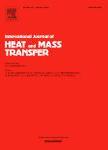版权所有:内蒙古大学图书馆 技术提供:维普资讯• 智图
内蒙古自治区呼和浩特市赛罕区大学西街235号 邮编: 010021

作者机构:Sejong Univ Dept Aerosp Engn Seoul 143741 South Korea Agcy Def Dev Daejeon 305600 South Korea
出 版 物:《INTERNATIONAL JOURNAL OF HEAT AND MASS TRANSFER》 (国际传热与传质杂志)
年 卷 期:2015年第88卷
页 面:330-337页
核心收录:
学科分类:080702[工学-热能工程] 08[工学] 0807[工学-动力工程及工程热物理] 0802[工学-机械工程] 0801[工学-力学(可授工学、理学学位)]
基 金:Space Core Technology Development Program of the National Research Foundation of Korea (NRF) - Ministry of Science ICT and Future Planning (MSIP) - Republic of Korea [NRF-2013M1A3A3A02042426]
主 题:Surface radiation Inverse analysis Particle swarm optimization algorithm Genetic algorithm
摘 要:The heat transfer mechanism of thermal radiation is directly related to either the emission and propagation of electromagnetic waves or the transport of photons. Depending on the participation of the medium in space, thermal radiation can be classified into two forms, which are surface and gas radiation, respectively. In the present study, unknown surface radiation properties are estimated by an inverse analysis for a surface radiation in an axisymmetric cylindrical enclosure. For efficiency, the repulsive particle swarm optimization (RPSO) algorithm, which showed an outstanding effectiveness in the previous inverse gas radiation problem, is adopted as an inverse solver. By comparing the convergence rates of an objective function and the estimated accuracies with the results of the hybrid genetic algorithm (HGA) and the particle swarm optimization (PSO) method, the performance of the RPSO algorithm is verified to be quite an efficient method as the inverse solver when applied to the retrieval of unknown properties of the surface radiation problem. (C) 2015 Elsevier Ltd. All rights reserved.